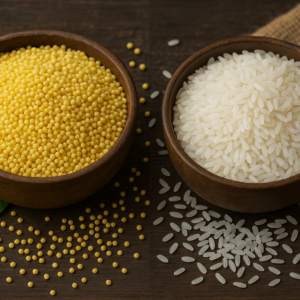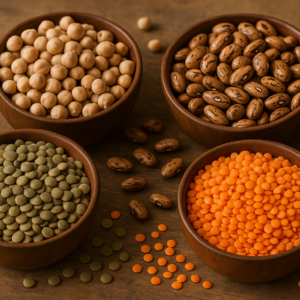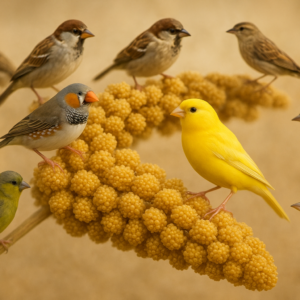Have you ever wondered about the ancient grains that have sustained civilizations for thousands of years? Among these nutritional powerhouses lies Red Bajri, a remarkable variety of pearl millet that’s gaining recognition as a superfood in modern nutrition circles. As climate change challenges traditional agriculture and health-conscious consumers seek nutrient-dense alternatives, Red Bajri emerges as both a sustainable solution and a nutritional champion.
Red Bajri, scientifically known as Pennisetum glaucum, represents one of nature’s most resilient and nutritious grains, offering exceptional health benefits while thriving in challenging environmental conditions.
Understanding Red Bajri: The Ancient Superfood
Red Bajri is a distinctive variety of pearl millet characterized by its reddish-brown grain color and exceptional nutritional density. Unlike its lighter counterparts, Red Bajri contains higher concentrations of antioxidants, particularly anthocyanins, which give it its characteristic color and enhanced health properties.
This drought-resistant crop has been cultivated for over 4,000 years across Africa and Asia, with India being one of the largest producers. The “red” variety stands out not just for its appearance but also for its superior nutrient profile compared to regular pearl millet varieties.
Pearl millet, including Red Bajri, belongs to the grass family and represents one of the world’s most important cereal crops in arid and semi-arid regions. Its ability to grow in poor soils with minimal water makes it an invaluable crop for sustainable agriculture.
Comprehensive Red Bajri Benefits for Health
Cardiovascular Health Enhancement
Red Bajri benefits extend significantly to heart health through multiple mechanisms. The grain contains high levels of magnesium, which helps regulate blood pressure and supports proper heart rhythm. Its alkaline nature contributes to reducing hypertension while promoting the production of red blood cells.
The fiber content in Red Bajri helps lower cholesterol levels by binding to bile acids and promoting their excretion. This process forces the body to use cholesterol to produce new bile acids, effectively reducing overall cholesterol levels in the bloodstream.
Blood Sugar Management
For individuals managing diabetes, Red Bajri offers exceptional benefits through its low glycemic index. The complex carbohydrates release glucose slowly into the bloodstream, preventing sudden spikes in blood sugar levels. This makes it an excellent grain choice for diabetic meal planning.
The high fiber content further aids in blood sugar regulation by slowing down carbohydrate absorption and improving insulin sensitivity. Regular consumption may contribute to better long-term glucose control.
Weight Management Support
Red Bajri benefits include significant support for weight management goals. The grain’s high protein and fiber content promotes satiety, helping individuals feel full for longer periods and reducing overall caloric intake.
The complex carbohydrates provide sustained energy release, preventing the energy crashes that often lead to unhealthy snacking. Additionally, the grain’s thermogenic properties may boost metabolic rate slightly, supporting calorie burning.
Digestive Health Improvement
The impressive fiber content in Red Bajri promotes healthy digestion by supporting regular bowel movements and feeding beneficial gut bacteria. This prebiotic effect contributes to overall digestive wellness and may enhance immune function.
The grain’s alkaline nature helps maintain optimal pH levels in the digestive system, reducing acidity-related discomfort and supporting nutrient absorption.
Bone Health and Mineral Support
Red Bajri provides essential minerals crucial for bone health, including phosphorus, magnesium, and calcium. These minerals work synergistically to maintain bone density and prevent age-related bone loss.
The grain also contains significant amounts of iron, making it valuable for preventing anemia and supporting healthy blood formation. This is particularly beneficial for women and growing children.
Red Bajri Nutrition Profile: A Powerhouse of Nutrients
Macronutrient Composition
Red Bajri nutrition stands out among cereal grains for its balanced macronutrient profile. A 100-gram serving typically contains:
Protein Content: Approximately 11-12 grams, making it comparable to wheat but with a superior amino acid profile. The protein quality is enhanced by the presence of essential amino acids, particularly lysine, which is often limiting in other cereals.
Carbohydrates: Around 67-70 grams, primarily in the form of complex carbohydrates that provide sustained energy release. The carbohydrate structure contributes to the grain’s low glycemic index properties.
Dietary Fiber: Contains 8-12 grams per 100 grams, significantly higher than refined grains and many other cereals. This fiber includes both soluble and insoluble types, contributing to various health benefits.
Fat Content: Low in fat at approximately 4-5 grams per 100 grams, with most fats being unsaturated and beneficial for health.
Essential Vitamin Content
Red Bajri nutrition includes several important vitamins that support overall health. The grain is particularly rich in B-complex vitamins, including niacin (Vitamin B3), which supports energy metabolism and nervous system function.
Folate content makes it beneficial for pregnant women and individuals requiring enhanced DNA synthesis support. The grain also contains smaller amounts of vitamins E and K, contributing to antioxidant protection and blood clotting functions.
Mineral Wealth
The mineral profile of Red Bajri is impressive, with significant amounts of iron, magnesium, phosphorus, and zinc. Iron content is particularly noteworthy, often exceeding that found in wheat and rice, making it valuable for preventing iron-deficiency anemia.
Magnesium supports over 300 enzymatic reactions in the body, including energy production and protein synthesis. The phosphorus content works with calcium to maintain strong bones and teeth.
Versatile Red Bajri Uses in Modern Cooking
Traditional Flatbread Preparations
One of the most popular Red Bajri uses involves creating nutritious flatbreads or rotis. The flour can be mixed with water and a pinch of salt to create a dough that’s rolled and cooked on a griddle. These rotis provide sustained energy and pair well with vegetables and legume-based dishes.
For enhanced flavor and nutrition, Red Bajri flour can be combined with other millet flours or small amounts of wheat flour to create more pliable dough while maintaining nutritional benefits.
Modern Breakfast Options
Red Bajri uses extend to contemporary breakfast preparations, including porridges and cereals. The grain can be cooked with milk or plant-based alternatives, sweetened with natural sweeteners, and topped with fruits and nuts for a nutritious morning meal.
Puffed Red Bajri makes an excellent addition to granola mixes or can be eaten as a standalone snack, providing sustained energy without excessive calories.
Baking Applications
The flour derived from Red Bajri can be incorporated into various baked goods, including cookies, muffins, and bread. When used in baking, it adds a slightly nutty flavor and dense texture while significantly boosting nutritional content.
For optimal results in baking, Red Bajri flour works best when combined with other flours, as its gluten-free nature may affect texture if used alone in traditional recipes.
Beverage Preparations
Traditional uses include creating fermented beverages that are both nutritious and refreshing. The grain can be soaked, fermented, and blended to create probiotic-rich drinks that support digestive health.
Modern applications include incorporating ground Red Bajri into smoothies and protein shakes, adding fiber, protein, and minerals to liquid nutrition preparations.
Cultivation and Sustainability Aspects
Red Bajri represents one of agriculture’s most sustainable crop options, requiring minimal water and thriving in poor soil conditions where other grains fail. This resilience makes it crucial for food security in regions affected by climate change.
The crop’s short growing season and ability to withstand extreme temperatures make it an environmentally friendly choice. Its cultivation supports soil health through nitrogen fixation and requires fewer chemical inputs than many conventional grains.
At CMS Industries, we recognize the importance of sustainable agricultural practices and work with farmers who employ environmentally conscious methods in producing high-quality grains and agricultural products. As leading Agricultural Products Manufacturers, Supplier & Exporters in India, we are committed to delivering excellence with every harvest.
Processing and Storage Considerations
Proper processing of Red Bajri involves cleaning, dehulling, and grinding to produce flour or preparing whole grains for cooking. Traditional stone grinding methods preserve more nutrients compared to industrial processing.
Storage requires keeping the grain in cool, dry conditions to prevent moisture accumulation and pest infestation. Properly stored Red Bajri can maintain its nutritional value for several months to a year.
For optimal nutrition retention, it’s recommended to purchase whole grains and grind them fresh when possible, as flour loses nutrients more rapidly than whole grains.
Incorporating Red Bajri into Daily Diet
Meal Planning Strategies
Successfully incorporating Red Bajri into daily nutrition requires strategic meal planning that considers taste preferences and nutritional goals. Starting with small portions and gradually increasing intake allows the digestive system to adapt to increased fiber content.
Combining Red Bajri with complementary proteins, such as legumes, creates complete amino acid profiles that support muscle maintenance and growth. This combination is particularly important for vegetarian and vegan diets.
Preparation Tips for Better Digestibility
Soaking Red Bajri overnight before cooking can improve digestibility and reduce cooking time. This process also helps activate enzymes that break down antinutrients, making minerals more bioavailable.
Fermentation techniques, traditional in many cultures, can further enhance digestibility while adding probiotics to the diet. These methods also improve flavor and may reduce any potential digestive discomfort for sensitive individuals.
Quality Considerations and Selection
When selecting Red Bajri, look for grains that are uniform in color, free from cracks or insect damage, and have a clean, fresh aroma. High-quality Red Bajri should have a deep, consistent red-brown color without excessive dust or foreign matter.
Organic varieties, when available, provide assurance of minimal pesticide exposure and often superior nutritional profiles due to soil quality and farming practices.
Future of Red Bajri in Global Nutrition
As global awareness of sustainable nutrition grows, Red Bajri is positioned to play an increasingly important role in addressing both nutritional needs and environmental challenges. Research continues to uncover additional health benefits and optimal processing methods.
The grain’s potential in functional food development presents opportunities for creating fortified products that address specific nutritional deficiencies while supporting sustainable agriculture.
Climate resilience makes Red Bajri particularly valuable as traditional crop yields face challenges from changing weather patterns and water scarcity.
Conclusion: Embracing the Red Bajri Revolution
Red Bajri represents more than just an ancient grain it embodies a sustainable approach to nutrition that honors traditional wisdom while meeting modern health needs. From its exceptional Red Bajri benefits for cardiovascular health and blood sugar management to its versatile Red Bajri uses in contemporary cooking, this remarkable grain offers solutions for both personal health and planetary wellness.
The comprehensive Red Bajri nutrition profile, featuring high protein, essential minerals, and beneficial fiber, positions it as a worthy addition to any health-conscious diet. As we face growing concerns about food security and environmental sustainability, crops like Red Bajri demonstrate that traditional solutions often hold keys to modern challenges.
Whether you’re seeking to improve your nutritional intake, manage specific health conditions, or simply explore new culinary horizons, Red Bajri offers a path toward better health and sustainable eating practices.
Ready to explore the benefits of premium agricultural products like Red Bajri? Contact CMS Industries to learn more about our range of high-quality grains and agricultural commodities that support both health and sustainability goals.
Frequently Asked Questions
Q1: What makes Red Bajri different from regular pearl millet?
Red Bajri contains higher levels of antioxidants, particularly anthocyanins, giving it a reddish color and enhanced nutritional properties compared to regular pearl millet varieties.
Q2: How much Red Bajri should I consume daily for health benefits?
A serving of 50-100 grams of cooked Red Bajri per day provides significant nutritional benefits while allowing your digestive system to adapt gradually.
Q3: Can people with gluten intolerance safely consume Red Bajri?
Yes, Red Bajri is naturally gluten-free, making it an excellent grain choice for individuals with celiac disease or gluten sensitivity.
Q4: Does Red Bajri require special cooking methods compared to other grains?
Red Bajri can be cooked similarly to rice or quinoa, though soaking beforehand improves digestibility and reduces cooking time significantly.
Q5: Where can I purchase high-quality Red Bajri for regular consumption?
Look for reputable agricultural suppliers who specialize in premium grains and ensure proper storage and handling for maximum nutritional value.





